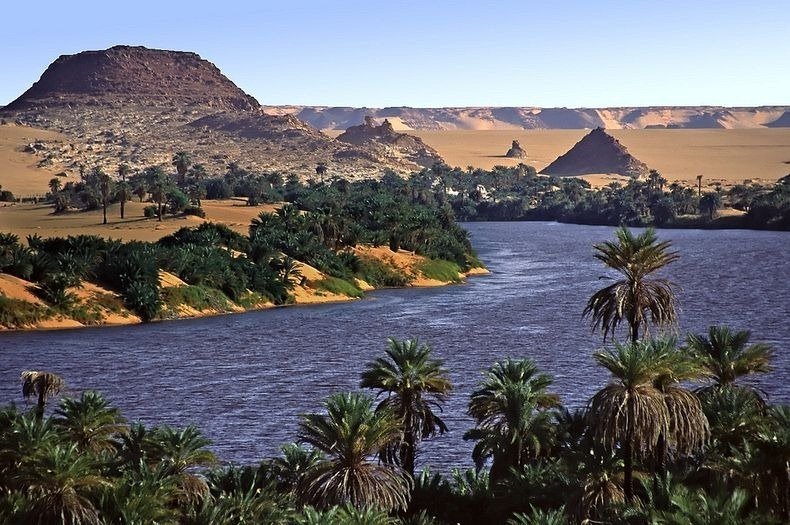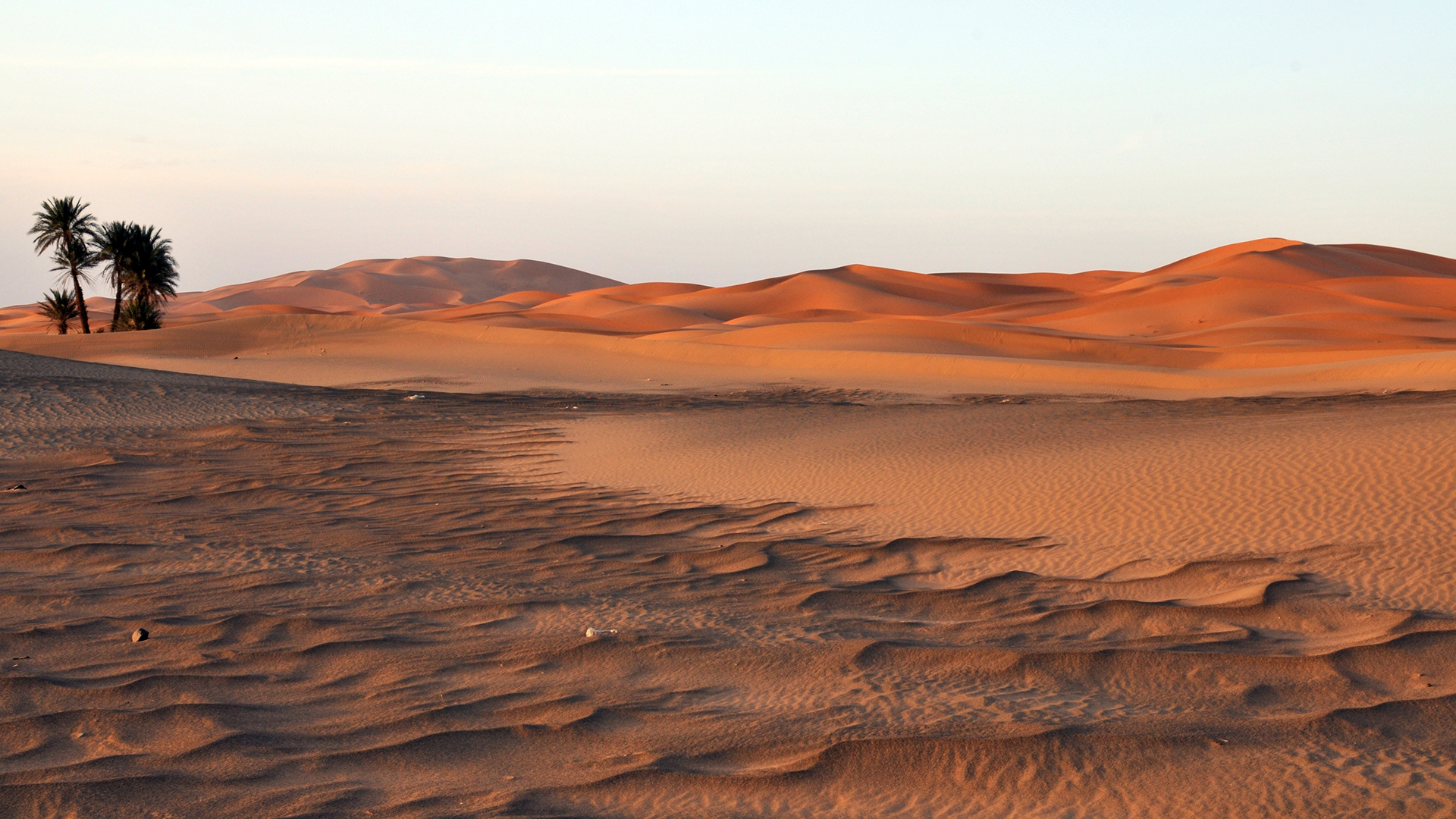Topic what animals live in the sahara desert: Discover the Sahara Desert"s unique wildlife, where each animal thrives in harsh conditions, showcasing nature"s incredible adaptability and diversity. From the majestic Saharan cheetah to the petite fennec fox, embark on a journey to explore these desert dwellers.
Table of Content
- What animals can be found living in the Sahara desert?
- Overview of Sahara Desert Geography
- Diverse Wildlife in Sahara
- Adaptations to Desert Life
- Endangered Species and Conservation Challenges
- Human Impact on Sahara"s Wildlife
- YOUTUBE: Top 10 Animals in the Sahara Desert - Endangered & Unique Animals
- Conservation Efforts and Initiatives
- Unique Behavioral Traits of Sahara Animals
- Impact of Climate Change and Desertification
- Interaction Between Sahara Animals and Plants
- Cultural and Historical Significance of Sahara Animals
What animals can be found living in the Sahara desert?
READ MORE:
Overview of Sahara Desert Geography
The Sahara Desert, derived from the Arabic word ṣaḥrā" meaning "desert", is the largest hot desert in the world. Covering much of North Africa, it spans from the Red Sea in the east to the Atlantic Ocean in the west, and from the Mediterranean Sea in the north to the Sahel in the south. The Sahara covers large parts of Algeria, Chad, Egypt, Libya, Mali, Mauritania, Morocco, Niger, Sudan, Tunisia, and Western Sahara, encompassing approximately 9 million square kilometers.
This vast desert is characterized by diverse landscapes including rocky hamadas, massive sand dunes, and sparse grasslands. Its central region is hyperarid, while the northern and southern fringes have more vegetation and wildlife. The Sahara alternates between desert and savanna grassland in a 20,000-year cycle due to Earth"s axial precession. Landforms such as the Richat Structure and various mountains, including the Aïr, Ahaggar, and Tibesti, add to its geographical diversity. The highest peak is Emi Koussi, a shield volcano in the Tibesti range of northern Chad.
- Area: Approximately 9 million square kilometers, about 31% of Africa.
- Countries: Includes parts of Algeria, Chad, Egypt, Libya, Mali, Mauritania, Morocco, Niger, Western Sahara, Sudan, and Tunisia.
- Landscapes: Features hamadas, ergs, dunes, wadis, and salt flats.
- Climate: Hyperarid central region with more vegetated northern and southern margins.
- Topography: Home to various mountain ranges and the unique Richat Structure.
- Flora and Fauna: While sparse, the region supports a range of adapted wildlife and vegetation.
The Sahara"s geography has influenced its history and the way of life of its inhabitants, shaping it as a region of fascinating diversity and extremities.
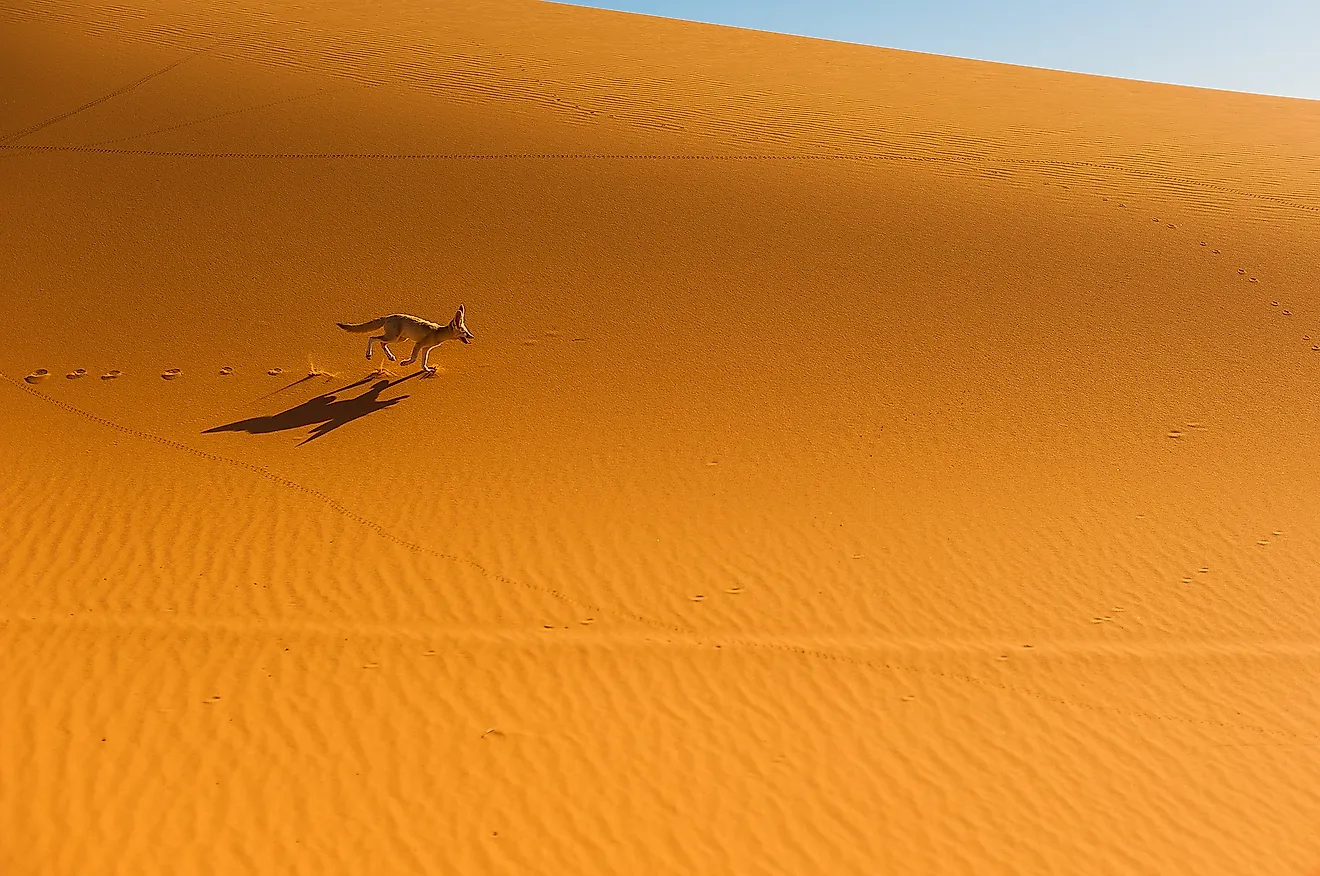
Diverse Wildlife in Sahara
The Sahara Desert, known for its extreme conditions, is home to a surprising variety of wildlife that have adapted to thrive in this harsh environment. From mammals and birds to reptiles and insects, each species has evolved unique adaptations to survive the extreme temperatures and scarce water resources.
- Mammals: The Sahara hosts mammals like the Fennec Fox, known for its large ears that dissipate heat; the Dromedary Camel, adapted to travel long distances without water; and the endangered Saharan Cheetah, adapted for high-speed pursuits in the desert landscape.
- Birds: Birds such as the majestic Ostrich, the world"s largest bird, and various raptors like the Secretary Bird, are well adapted to the desert environment.
- Reptiles: The desert is also home to a variety of reptiles like the venomous Horned Viper and the resilient Desert Monitor, each adapted to the sandy terrain and extreme heat.
- Insects: Arthropods like the Scarab Beetle, which plays a crucial role in the desert ecosystem, and various species of ants and scorpions, are common.
- Unique Adaptations: Animals here often have adaptations like nocturnal habits to avoid daytime heat, water conservation strategies, and specialized feeding habits to survive in this arid region.
Despite the challenging conditions, the Sahara"s diverse wildlife is a testament to the resilience and adaptability of life. These species not only manage to survive but also maintain a delicate ecological balance in one of the harshest environments on Earth.
Adaptations to Desert Life
The Sahara Desert"s wildlife has evolved fascinating adaptations to thrive in the extreme desert climate. The harsh environment, characterized by hyper-arid conditions, fierce winds, and wide temperature swings, has led to a diverse range of survival strategies among the desert inhabitants.
- Physiological Adaptations: Many mammals are relatively small to minimize water loss and often meet their water needs through their diets. Creatures like the fennec fox have developed large ears for heat dissipation and hairy soles for foot protection.
- Behavioral Adaptations: Animals tend to be nocturnal, hunting and foraging at night to avoid the extreme daytime heat. Many species take refuge in burrows during the day.
- Feeding Adaptations: The diet of Sahara wildlife varies, with some animals like the dromedary camel adapted to feed on thorny plants, salt-laden vegetation, and dry grasses.
- Reproductive Strategies: Some species have adapted their reproductive cycles to align with the harsh environment, ensuring the survival of their offspring.
- Camouflage and Defense: Animals such as the deathstalker scorpion use coloration for camouflage, while others, like the Saharan cheetah, have evolved to be efficient predators even in challenging conditions.
This array of adaptations showcases the resilience and ingenuity of life in the Sahara, enabling a rich tapestry of species to flourish in one of the most challenging environments on Earth.
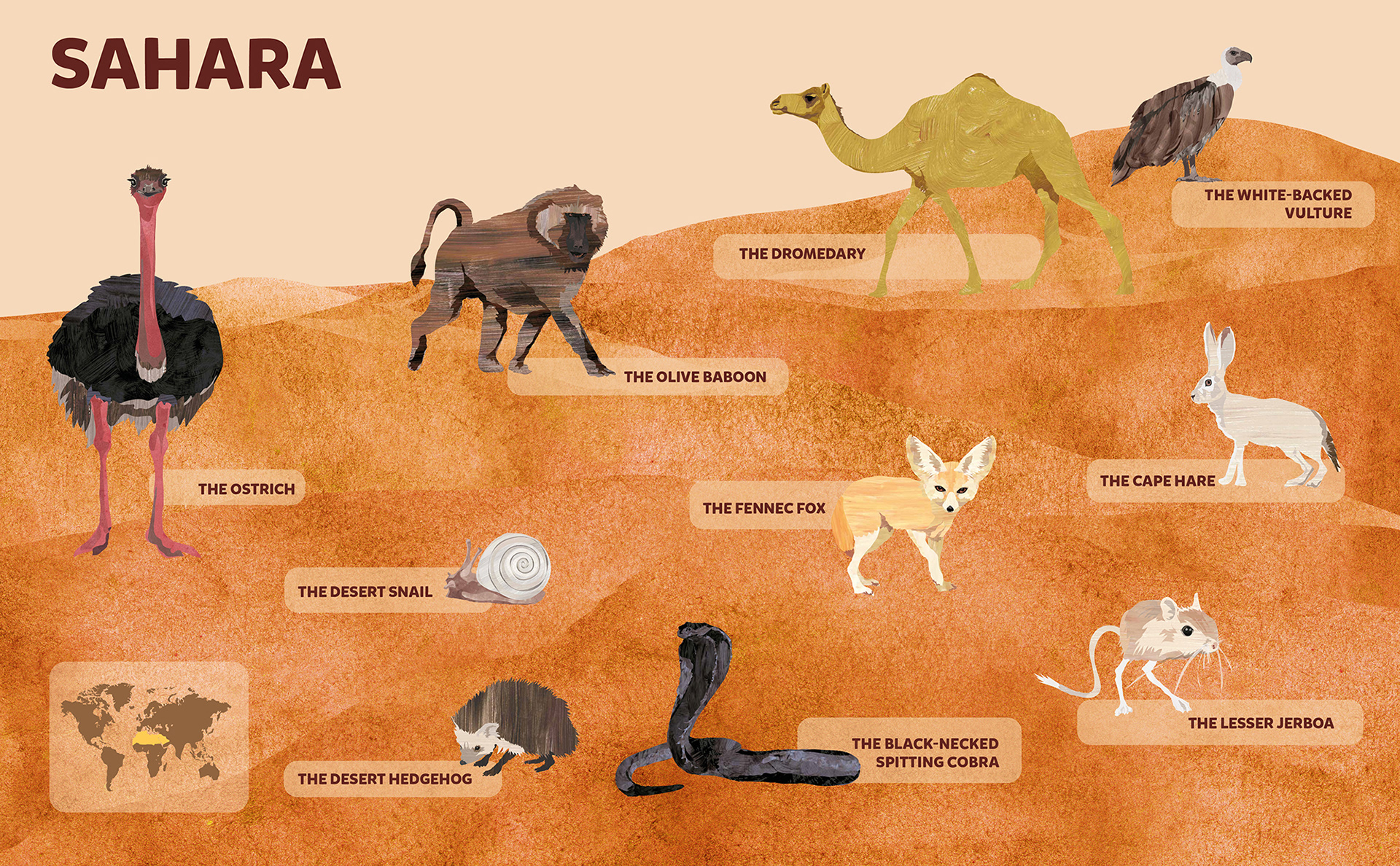
Endangered Species and Conservation Challenges
The Sahara Desert is facing significant conservation challenges, with numerous species currently endangered due to various factors. Habitat destruction, climate change, and human activities have had a profound impact on the desert"s biodiversity.
- Saharan Cheetah: One of the most critically endangered species, the Saharan Cheetah is on the brink of extinction with fewer than 250 adults remaining. This subspecies is adapted to the harsh desert environment, but its survival is threatened by habitat loss and human encroachment.
- Addax Antelope: Once widespread, the Addax Antelope has faced a dramatic decline due to hunting and habitat destruction. Efforts are being made to conserve this species, but it remains critically endangered.
- Other Vulnerable Species: The Sahara is also home to species like the Barbary Sheep, Dama Gazelle, and the Anubis Baboon, each facing their own challenges from human activities and environmental changes.
- Conservation Efforts: There are ongoing efforts to protect these species, including habitat conservation, anti-poaching measures, and breeding programs. However, the vastness and inaccessibility of the Sahara make these efforts challenging.
- Human Impact: The expanding human footprint, including agriculture and urbanization, continues to threaten the fragile desert ecosystem, making conservation a complex issue.
Addressing these challenges requires a concerted effort from conservation organizations, governments, and local communities to ensure the survival of these unique species that call the Sahara their home.
Human Impact on Sahara"s Wildlife
The Sahara Desert, while a vast and resilient ecosystem, has not been immune to the impacts of human activities. These impacts have significantly affected the desert"s unique wildlife, leading to various environmental challenges.
- Habitat Destruction: Expanding human settlements, agriculture, and infrastructure development have led to habitat loss, fragmenting the once contiguous desert ecosystem and putting pressure on wildlife populations.
- Climate Change: Climate change is altering the Sahara"s environment, impacting the availability of water and food resources, and thereby affecting the survival of desert species.
- Overexploitation: Hunting and poaching for trade, food, or sport have led to the decline of several species, including the Saharan Cheetah and the Addax Antelope.
- Invasive Species: Introduction of non-native species has disrupted the natural balance of the Sahara ecosystem, leading to competition and predation on native species.
- Pollution: Pollution from various sources, including oil exploration and mining, poses a threat to the delicate desert environment and its inhabitants.
These challenges highlight the need for concerted conservation efforts to protect the Sahara"s wildlife and maintain the ecological integrity of this unique desert landscape.
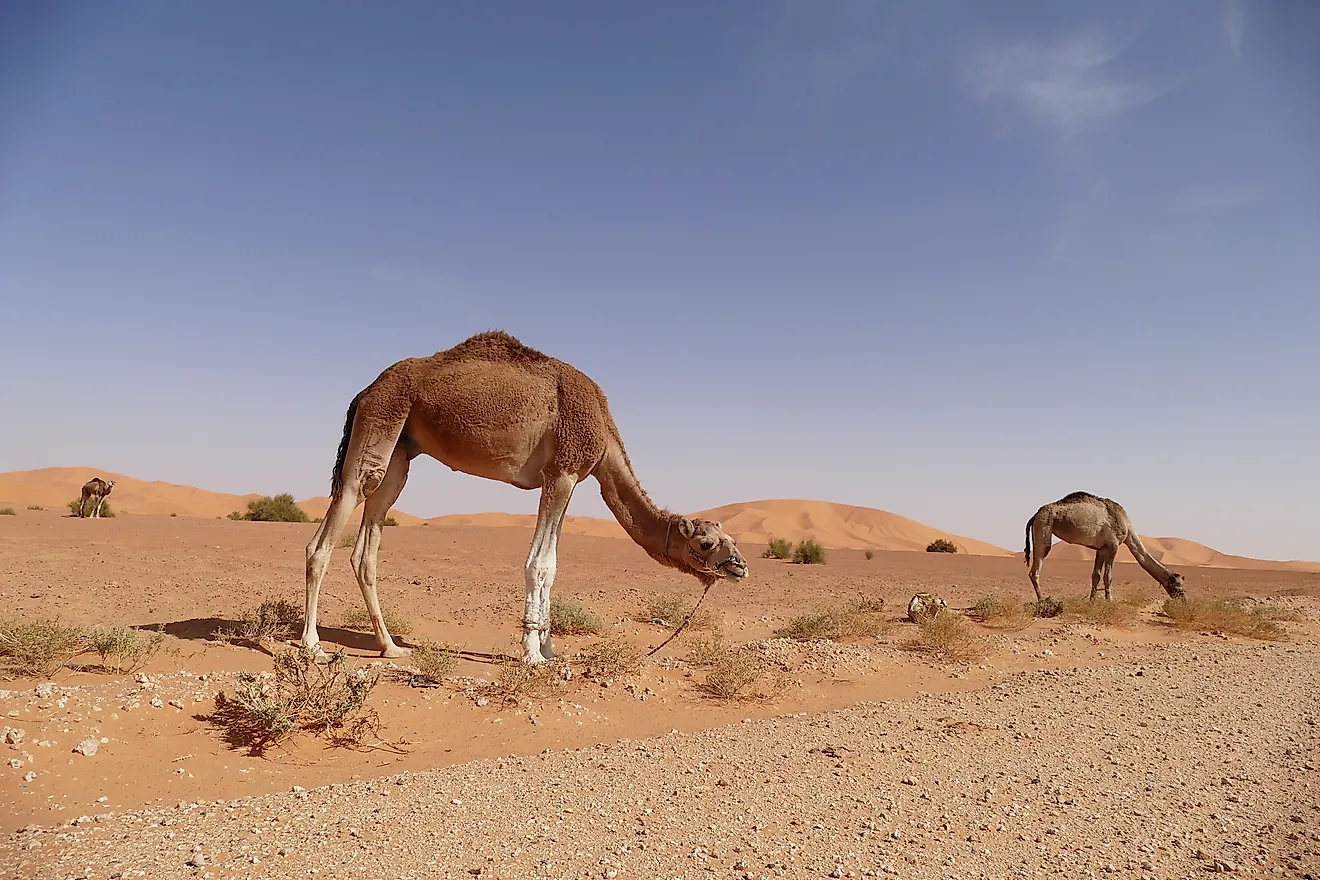
Top 10 Animals in the Sahara Desert - Endangered & Unique Animals
Dive into the enchanting world of Sahara Desert animals and witness the incredible resilience and beauty that thrives amidst the harsh and arid landscape. Discover the secrets of these extraordinary creatures in this captivating video that will leave you in awe of nature\'s wonders.
Conservation Efforts and Initiatives
The Sahara Desert, with its unique and diverse wildlife, is the focus of various conservation efforts and initiatives. These efforts aim to protect and preserve the desert"s ecosystem amidst the challenges posed by human activities and environmental changes.
- International and Local Conservation Programs: Various organizations, including NGOs and research institutions, collaborate with governments and local communities to implement conservation strategies. These programs often focus on habitat preservation, species protection, and sustainable practices.
- Protected Areas and Wildlife Reserves: The establishment of national parks, nature reserves, and conservancies is a key strategy. These areas provide safe havens for wildlife and help in preserving natural habitats.
- Research and Monitoring: Scientific research and monitoring are crucial for understanding the needs of different species and the impact of environmental changes. Techniques like satellite tracking and camera traps are used for wildlife monitoring.
- Combating Poaching and Illegal Trade: Efforts are made to combat poaching and the illegal wildlife trade, which threaten many Sahara species. This includes enforcing stricter regulations and raising public awareness.
- Climate Change Mitigation: Addressing the broader issue of climate change is vital for the long-term conservation of the Sahara Desert. Initiatives include advocating for sustainable practices and supporting climate change research.
Through these concerted efforts, there is hope for the preservation of the Sahara"s unique biodiversity, ensuring its survival for future generations.
10 Types of Animals Found in the Desert
Prepare to be amazed as you explore the diverse and fascinating world of desert animals. From camels and scorpions to snakes and lizards, this mesmerizing video takes you on an unforgettable journey into the extraordinary lives of these incredible creatures. Don\'t miss out on this chance to uncover the hidden treasures of the desert!
Unique Behavioral Traits of Sahara Animals
The Sahara Desert"s animal inhabitants exhibit a range of unique behavioral traits that have evolved to adapt to the extreme conditions of their environment. These behaviors are not only fascinating but also crucial for their survival in the harsh desert landscape.
- Jerboa: Known for their extraordinary jumping abilities, Jerboas use long hind legs to propel themselves across the desert. Their large ears aid in thermoregulation, and they have efficient kidneys for water conservation. Jerboas typically live in family groups and mate for life.
- Ostrich: Despite being flightless, ostriches are one of the fastest land animals. They use their strong legs for defense and have excellent eyesight and hearing for predator detection. Ostriches stay near watering holes and are known to act as guards for nearby grazing herds.
- African Wild Dog: These tenacious predators are known for their stamina, chasing prey over long distances. They have a high hunting success rate and exhibit strong herd instincts, ensuring that all members, including the old and young, are well-fed.
- Saharan Cheetah: This subspecies of cheetah hunts primarily at night and can sustain for longer periods without water. They have adapted to the desert"s harsh climate with faintly-colored and shorter coats compared to other cheetahs.
- Fennec Fox: The smallest canid in the world, the Fennec Fox, has large ears for hearing and thermoregulation. They are adept at climbing and have kidneys adapted to minimize water loss.
- Sand Cat: Sand cats are superbly adapted to the desert, able to live without water and navigate shifting sands. They hunt by detecting prey underground and are skilled snake hunters.
These unique behavioral traits demonstrate the incredible adaptability of Sahara Desert animals, enabling them to thrive in one of the most challenging habitats on Earth.

Impact of Climate Change and Desertification
The Sahara Desert is increasingly feeling the impact of climate change and desertification, phenomena that are altering its landscape and affecting its wildlife. These environmental changes pose significant challenges to the survival of desert species and the balance of the ecosystem.
- Increasing Temperatures and Drought: Rising temperatures and prolonged drought periods due to climate change are exacerbating the aridity of the Sahara, affecting water availability and food sources for animals.
- Habitat Loss: Desertification leads to the expansion of desert areas, encroaching on the habitats of various species. This results in a loss of suitable living spaces and a reduction in resources necessary for survival.
- Changes in Species Distribution: As the desert environment becomes more hostile, some species may migrate to more hospitable areas, while others may face increased risks of extinction.
- Altered Ecosystem Dynamics: The changing climate impacts the availability of prey and alters the timing of various life cycles, disrupting the ecological balance.
- Threats to Endangered Species: Species already facing threats, such as the Saharan Cheetah, are further imperiled by the worsening conditions caused by climate change and desertification.
Addressing these impacts requires global efforts in climate change mitigation and sustainable management of the Sahara"s natural resources to preserve its unique ecosystem and the wildlife that depends on it.
Interaction Between Sahara Animals and Plants
The Sahara Desert, while harsh and arid, hosts a unique interplay between its fauna and flora. This interaction is crucial for the survival of both animals and plants in such an extreme environment.
- Food and Shelter: Plants provide essential food and shelter for many desert animals. For instance, the Fennec Fox and Jerboa consume plant matter for hydration, while larger animals like the Ostrich may feed on grasses and bushes.
- Seed Dispersal: Animals play a significant role in seed dispersal for desert plants. The movements of animals such as the Gerbil or the Anubis Baboon aid in distributing plant seeds, facilitating plant reproduction and diversification.
- Pollination: Some desert animals contribute to the pollination of plants. Insects, birds, and even small mammals can assist in the pollination process, ensuring the continuation of plant species.
- Camouflage and Protection: The coloring and structure of desert plants often provide camouflage for animals like the Deathstalker Scorpion and Saharan Cheetah, helping them avoid predators or ambush prey.
- Mutualistic Relationships: Certain desert animals have developed mutualistic relationships with plants, where both species benefit. For example, some bird species might nest in thorny plants for protection, while also aiding in pest control for the plant.
The intricate relationship between animals and plants in the Sahara highlights the interconnectedness of life, even in one of the most challenging habitats on Earth.
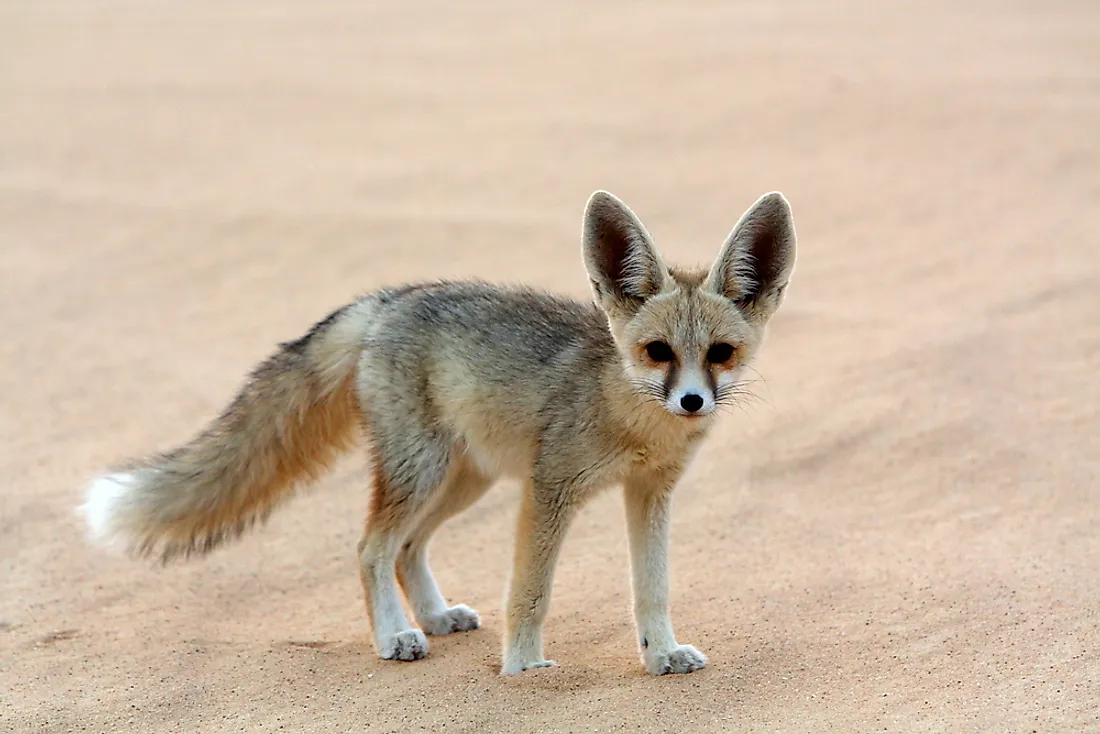
READ MORE:
Cultural and Historical Significance of Sahara Animals
The animals of the Sahara Desert hold significant cultural and historical importance for the people living in and around this vast region. These animals have not only adapted to the harsh desert conditions but have also become integral to the cultural identity and survival of local communities.
- Dromedary Camel: The dromedary camel, a symbol of the Sahara, has been domesticated for thousands of years. It is crucial for transportation and as a source of food and materials, embodying the spirit of resilience and adaptation in the desert.
- Fennec Fox: Known as the smallest canid, the Fennec Fox, with its distinct large ears, is a popular figure in local folklore and symbolizes cleverness and survival in harsh conditions.
- Saharan Cheetah: The Saharan Cheetah, now facing extinction, represents the fragility of desert life. It holds a special place in the region"s natural heritage and highlights the need for conservation efforts.
- African Wild Dog: Revered for its hunting prowess and social structure, the African Wild Dog is admired in local cultures for its strength, cooperation, and endurance.
- Ostrich: The Ostrich, the world"s largest bird, found in parts of the Sahara, has cultural significance, appearing in art and folklore, symbolizing speed and the ability to navigate challenging environments.
These animals are not just residents of the Sahara but are deeply woven into the fabric of its history, culture, and daily life, reflecting the interconnectedness of humans and nature in this unique landscape.
The Sahara"s wildlife, resilient and diverse, mirrors the desert"s majestic yet challenging nature. These animals, thriving in one of Earth"s most extreme habitats, are a testament to the adaptability and beauty of life under the Saharan sun.
